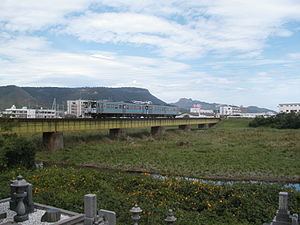Type Heavy rail Opened 1899 Line length 74.5 km (46.3 mi) | Stations 29 Track gauge 1,067 mm (3 ft 6 in) | |
 | ||
1500 1000 jr shikoku kotoku line 1500 series and 1000 series dmu
The Kōtoku Line (高徳線, Kōtoku-sen) is a railway line owned and operated by Shikoku Railway Company (JR Shikoku). It connects the prefectural capitals of Takamatsu in Kagawa Prefecture and Tokushima in Tokushima Prefecture. The route approximates the northeastern coast of the island of Shikoku. Its name comes from the characters in the names of the prefectures that the line connects: Takamatsu (高松) and Tokushima (徳島).
Contents
- 1500 1000 jr shikoku kotoku line 1500 series and 1000 series dmu
- Services
- Station list
- History
- Former connecting lines
- References
Sanuki, the name of the ancient province that preceded the modern Kagawa Prefecture, appears in the names of some stations on the line.
Services
The Uzushio limited express serves the entire line. Two round-trips per day run through to/from Okayama.
In addition to local trains that run the entire length of the Kōtoku Line, there are trains that run between Takamatsu and Orange Town, Sambommatsu, and Hiketa, as well as between Tokushima and Itano and Tokushima and Hiketa. For a single-tracked line service levels are quite high, except along the prefectural border between Itano and Hiketa. In Tokushima there are through trains to/from the Naruto and Mugi lines, with one train per day running from Takamatsu to Mugi via Anan.
Since the completion of electrification work between Takamatsu and Iyoshi on the Yosan Line, the Kōtoku Line has received some of the newest DMUs on the JR Shikoku network. Local services often use 1000 series, 1200 series and 1500 series DMUs, while limited express services are handled by N2000 series DMUs.
Station list
History
The first part of what is now the Kotoku Line was built by the Tokushima Railway, being the Sako to Tokushima section of its line from Kamojima (now the Tokushima Line) opened on February 16, 1899. That company was nationalised in 1907. In 1916 the Awa Electric Railway opened a line from Nakahara to Naruto, including the Yoshinari to Ikenotani section, which is now part of the Kotoku Line. The Takamatsu to Hikida section was opened between 1925-28 by the (then) Japanese Imperial Railways.
In 1933 the Awa Electric Railway was nationalised, and in 1935 the Hikida to Ikenotani and Yoshinari to Sako sections were opened, completing the line.
In 1977 CTC signalling became operational for the line, and freight operations ceased in 1986.
With the privatization of JNR, the line became part of the Shikoku Railway Company (JR Shikoku) on April 1, 1987. On June 1, 1988 the line name changed from Kōtoku Main Line to Kōtoku Line.
The elevated Sako Station was commissioned in 1993, and in 1998 track improvement allowing faster speeds was completed, and Orange Town Station opened.
